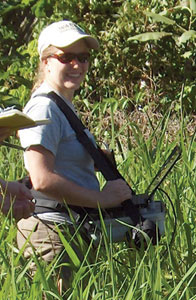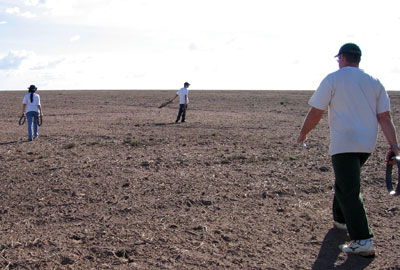 |
From Catalyst magazine, Spring 2008
Science as a Calling
 |
|
 |

Vital Statistics:
Gillian Galford
Hometown:
Portland, Oregon
Degrees: B.A; Earth & Planetary Sciences/Environmental Studies, Washington University, St. Louis (2004); M.Sc., Geological Sciences, Brown-MBL Graduate Program in Biological and Environmental Sciences (2006)
At present: Galford expects to complete her doctorate in the Brown-MBL program in 2009.
Unusual field experience: In Tanzania, Galford conducted an independent study of elephant migration corridors that revealed a complex pattern of movement through national parks, conservation areas, protected forests and—at a critical crossroads—a private ranch. “Keeping the elephants from raiding farms for food saved many of their lives,” she says.
|
Finding community, in many ways, in the Brown-MBL graduate program
By Gillian Galford
As I stand in a sweeping field of soybean crop that, just a few years ago, was native savanna, I realize I am in exactly the place I want to be.
Here, in the Brazilian Amazon, I am pursuing science I am passionate about in a socially relevant context. As I explore how the conversion to agriculture — which is rapidly altering the Amazon — impacts the release of greenhouse gases from soil, I can connect with Brazilian residents and their concerns. Here, I can put into action a lesson I have learned over many years:
What is best for the environment is also best for the local community.
The path that led me to the Brown-MBL graduate program — and to this leafy soybean field — began long ago. As a child, I spent hours combing the Oregon coast for small rocks to add to my collection. (No one guessed that I would become a geologist.) During high school, I taught soil sciences to middle-school students in an outdoor education program. I explored the woods, tidal pools, and rivers with strong mentors, gaining a sense of place, a passion for learning about the natural world, and a strong environmental ethic.
As a teenager, I witnessed the human-development aspects of environmental sustainability when I served as a supervisor for Amigos de las Americas. We helped communities in the Dominican Republic and Paraguay take on self-identified issues, including public health concerns that had a strong connection to the local environment (such as latrine construction). A few years later, as an undergraduate at Washington University, I spent a semester studying wildlife management in the greater Serengeti ecosystem in Tanzania, Africa. There, too, I saw firsthand that the health of the environment and of societies are closely coupled. Efforts towards environmental preservation are only sustainable if they include the wellbeing of neighboring communities.
I pursued an academic breadth in college — from the ecology of the Serengeti, to the geology of Hawaiian volcanoes, to environmental problems in U.S. history, to energy issues. I also worked in a NASA-funded remote sensing lab. These experiences reinforced for me the strength of spatial analysis in the environmental sciences, such as remote sensing and Geographic Information Systems (GIS) technologies, particularly at the interface of policy and management.
When it came time to search for a graduate school, I sought out programs where I could pursue my interest in remote sensing applications to earth systems science. This led me to Jack Mustard, professor of Geological Sciences at Brown University. The opportunities at Brown, including the new Brown-MBL joint program, sounded perfect. I connected with Jerry Melillo, co-director of the MBL Ecosystems Center, as a potential mentor, and we decided to bridge Brown’s expertise in remote sensing with the MBL’s expertise in ecosystems modeling to address environmental sustainability.
 |
 |
Galford’s research colleagues from the University of Sao Paulo set out to make gas flux measurements on a tilled soybean field during the dry season (Comodoro, state of Mato Grosso, Brazil).
|
|
Jerry’s work in the Brazilian Amazon immediately drew me in. The landscape there is rapidly transforming as Brazil seeks to meet social and economic goals through agricultural development, such as converting savanna lands to soybean farms for cash-crop export. What are the environmental impacts of this large-scale conversion of forest and savanna to intensive, row-crop agriculture? For my doctoral research, I am estimating greenhouse-gas emissions from land-use and land-cover change in the region. Practices such as tillage, fertilization, and irrigation impact the greenhouse gases that are emitted from soil; this release of carbon and nitrogen means the soils are losing nutrients. Local farmers want to know how to conserve nutrients in their soils, which we can help them do as we find ways to manage agriculture to reduce greenhouse-gas emissions. On a larger scale, Brazil is interested in the carbon trading market, where reductions in carbon dioxide emissions are economically rewarded. Managing Brazil’s agricultural resources as a carbon sink, rather than a carbon source, makes economic as well as environmental sense.
When I started out in the Brown-MBL program, I knew it would be an adventure. I was a part of the first class admitted, so some bumps in the road were expected, but I also looked forward to shaping my own highly unique graduate experience. The program gives me access to a diverse range of expertise, as well as the opportunity to travel and work with international collaborators and contribute to an interdisciplinary group to synthesize research findings in the Amazon. Beyond that, I’ve found a niche in which I can apply my passion for earth-systems science to a topic relevant to society. In short, I’ve found a calling.
|